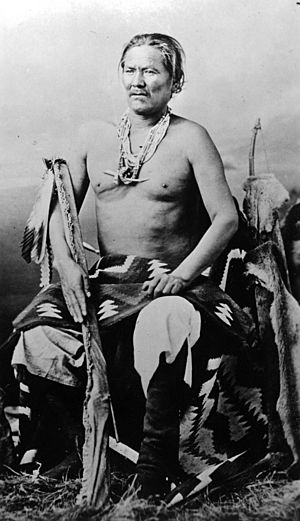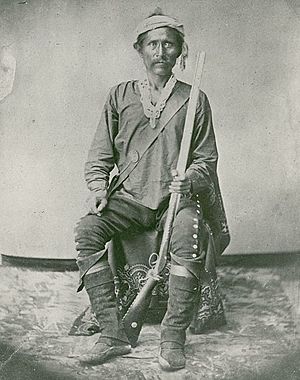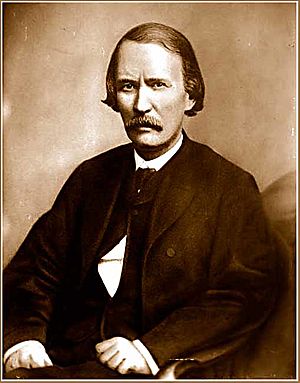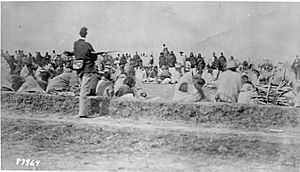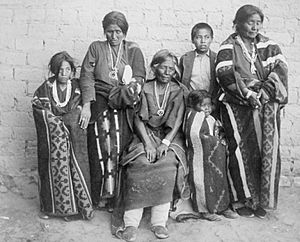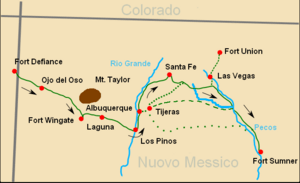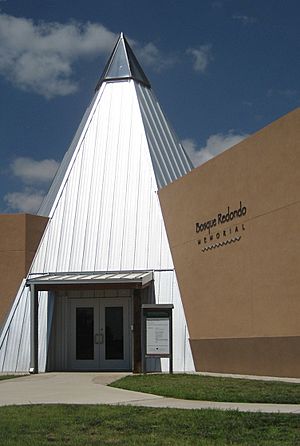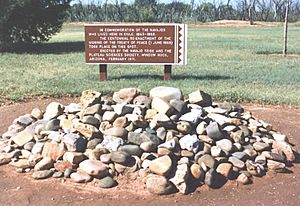Long Walk of the Navajo facts for kids
Quick facts for kids Long Walk of the Navajo |
|
|---|---|
| Part of the Navajo Wars | |
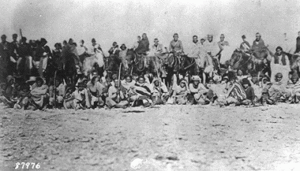
Navajo people photographed during the Long Walk
|
|
| Location | Southwestern United States |
|
Attack type
|
Forced displacement |
| Deaths | At least 200 |
| Victims | Navajo people |
| Assailants | U.S. Federal Government, U.S. Army |
| Motive | Acquisition of Navajo lands and forced cultural assimilation of Navajo people |
The Long Walk of the Navajo, also known as the Long Walk to Bosque Redondo (Navajo: Hwéeldi), was a forced journey in 1864. The U.S. government made the Navajo people leave their homes. They were forced to walk from their land in what is now Arizona to eastern New Mexico. About 53 different forced marches happened between August 1864 and the end of 1866. Some experts say that the "collective trauma of the Long Walk...is critical to contemporary Navajos' sense of identity as a people." This event deeply shaped who the Navajo are today.
Contents
Understanding the Long Walk
The Navajo people traditionally lived in a large area. This land stretched from Arizona through western New Mexico. Here, the Navajo built homes, grew crops, and raised animals. For a long time, different groups in the Southwest would raid and trade with each other. This included the Navajo, Spanish, Mexicans, Pueblos, Apache, Comanche, Ute, and later European Americans. Sometimes, these conflicts involved individuals seeking their own interests.
Problems between European Americans and Navajos grew after a respected Navajo leader named Narbona was killed in 1849. In August 1851, the U.S. government built Fort Defiance and Fort Wingate. Before the Long Walk, several treaties were signed in 1849, 1858, and 1861.
Conflicts Before the Long Walk
There were many disagreements between European Americans and Navajo groups. This happened between 1846 and 1863. Navajo leaders like Manuelito (Hastiin Chʼil Haajiní) and Barboncito (Hastiin Dághaaʼ) spoke about the U.S. Army's actions. They said the Army was bringing in troops to fight. They also mentioned that the Army had harmed a Navajo messenger. The Army also opened fire on a tribal leader during peace talks.
The Navajo leaders also pointed out that the Army did not provide food for their many animals at Fort Defiance. Instead, the Army took over good grazing land. They even killed Manuelito's livestock that was there. On April 30, 1860, Manuelito and Barboncito led 1,000 Navajo warriors in an attack on the fort. They almost took control of it.
Typical agreements and treaties stated that the Army would protect the Navajo. However, the Army allowed other Native American tribes and Mexicans to steal Navajo livestock. They also allowed them to capture Navajo people to be used as slaves. A peace agreement between the Army and Navajo was signed on February 15, 1861. The Navajo were again promised protection. But as part of the agreement, two of the Navajo's four sacred mountains were taken. About one-third of their traditional land was also lost.
In August 1861, Lt. Col. Manuel Antonio Chaves took command of a group of soldiers at Fort Fauntleroy. There was a dispute during horse races at the fort. Shots were fired, and about 200 Navajo, who were armed and on horseback, moved towards the soldiers. The soldiers fired back, and 12 Navajo were killed. Forty others were taken prisoner.
Civil War and Kit Carson's Role
When Confederate troops moved into southern New Mexico, the U.S. Army tried to get friendly Navajos to move to a safe camp. They were offered government protection there. All Navajos who refused to move were warned they would be treated as enemies. Some Navajos agreed to move.
By 1862, the Union Army had pushed the Confederates out of the area. The U.S. government then focused on the Navajos. They wanted to stop all raiding by and on the Navajo people. James H. Carleton became the commander for the New Mexico Military Department in September 1862. Carleton ordered Colonel Christopher "Kit" Carson to go to Navajo land. Carson was told to accept the Navajo's surrender by July 20, 1863.
When no Navajos came to surrender, Carson and another officer went into Navajo territory. They tried to convince the Navajos to give up. They also used a scorched earth policy. This meant destroying everything in the Navajo homeland. They burned crops and homes to starve the Navajo out. This forced them to surrender. By early 1864, thousands of Navajo began to surrender to the Army. Some Navajos refused to surrender. These groups scattered to places like Navajo Mountain, the Grand Canyon, and parts of Utah.
The Long Walk Journey
Major General James H. Carleton was sent to the New Mexico Territory in late 1862. His goal was to control the Navajos and force them on the Long Walk to Bosque Redondo. Carleton set rules for the Navajos. They were not allowed to trespass on lands, raid other tribes, or fight with Spaniards and European Americans. Most Navajos followed these rules. However, some small groups of Navajo raiders broke them. Because of this, the entire tribe was punished. Carleton felt he was not succeeding. So, he asked for help from others, including the famous mountain man Kit Carson.
Carson also got help from neighboring tribes to capture as many Navajos as possible. The Utes were very helpful. They knew the Navajo lands well and were familiar with Navajo strongholds. Carson launched his full attack on the Navajo people in January 1864. He destroyed everything in his path. He ruined the Navajo way of life. Their traditional homes (hogans) were burned. Livestock were killed, and irrigated fields were destroyed. Navajos who surrendered were taken to Fort Canby. Those who fought back were killed. Some Navajos managed to escape Carson's campaign. But they were soon forced to surrender due to hunger and the cold winter weather.
The "Long Walk" began in the spring of 1864. Groups of Navajo, led by the Army, were moved from their traditional lands. These lands were in eastern Arizona Territory and western New Mexico Territory. They were taken to Fort Sumner, in an area called Bosque Redondo or Hwéeldi by the Navajo. (Bosque Redondo means "round forest" in Spanish, referring to a river-bottom forest with cottonwood trees.)
The march was very hard. It pushed many Navajos to their breaking point, and some died. The distance was cruel, and the soldiers gave no help. Not everyone was strong enough to walk 400 miles. Many started the walk tired and hungry. Others were not dressed properly and were not ready for such a long journey. The Navajos received no sympathy. They were never told where they were going, why they were being moved, or how long it would take. One story passed down through Navajo generations shows the Army's attitude:
It was said that those ancestors were on the Long Walk with their daughter, who was pregnant and about to give birth [...] the daughter got tired and weak and couldn't keep up with the others or go further because of her condition. So my ancestors asked the Army to hold up for a while and to let the woman give birth, but the soldiers wouldn't do it. They forced my people to move on, saying that they were getting behind the others. The soldier told the parents that they had to leave their daughters behind. "Your daughter is not going to survive, anyway; sooner or later she is going to die," they said in their own language. "Go ahead," the daughter said to her parents, "things might come out all right with me," But the poor thing was mistaken, my grandparents used to say. Not long after they had moved on, they heard a gunshot from where they had been a short time ago.
At least 200 people died during one 18-day, 300-mile (500-km) walk. Between 8,000 and 9,000 people were settled in an area of 40 square miles (104 km²). The population reached a high of 9,022 by the spring of 1865.
There were as many as 50 groups taking one of seven known routes. Each group took a different path but followed the same general trail. When returning to the Navajo lands, they joined together into one large group. This group was ten miles (16 km) long. Some Navajos escaped and hid with Apaches. These groups later became known as the Alamo Band of the Diné (Navajos).
Slavery During the Campaign
The Army's effort to control the Navajo was made worse by raids from New Mexican and Ute slave traders. These raiders attacked isolated Navajo groups. They killed the men, took women and children captive, and stole horses and livestock. During the Army's campaign, Ute scouts working with the Army also took part in these activities. They left the destruction of Navajo homes and farms to the main Army unit. Even after the Navajo surrendered, the Utes and New Mexican slave traders continued to raid them. Many Navajo people were captured and sold as slaves throughout the region.
Life at Bosque Redondo
Bosque Redondo was like an internment camp for several tribes. It had serious problems. About 400 Mescalero Apaches were placed there before the Navajos arrived. The Mescaleros and the Navajo had a long history of raiding each other. The two tribes had many arguments while they were held together.
Also, the camp was planned for about 5,000 people, not 10,000 men, women, and children. Water and firewood were big problems from the start. The water was salty, and the small group of trees was not enough. Both nature and human mistakes caused crop failures every year. The corn crops were attacked by army worms and failed many times. The Pecos River flooded and destroyed the irrigation system.
In 1865, Navajos began to leave the camp. By 1867, the remaining Navajo refused to plant any crops. Comanches often raided them, and the Navajo also raided the Comanche. Once, they stole over 1,000 horses. The non-Indian settlers in the area also suffered from these raids. The Navajo were trying to feed their starving people at Bosque Redondo.
There was also poor management of supplies bought for the reservation. The Army spent as much as $1.5 million a year to feed the Native Americans. In 1868, this experiment was given up. It was meant to be the first Indian reservation west of Indian Territory. A memorial site honoring those held at Bosque Redondo is located at Fort Sumner, New Mexico.
The Treaty of Bosque Redondo
The Treaty of Bosque Redondo was signed between the United States and many Navajo leaders. This happened at Fort Sumner on June 1, 1868. The treaty included several important points. It set up a reservation for the Navajo. It also placed limits on raiding. There would be a government agent living on the reservation. Children would have to go to school. The government would provide seeds, farming tools, and other supplies. The treaty also promised to protect the rights of the Navajos. It mentioned building railroads and forts. It also included payments to tribal members and plans for the Navajos to return to their new reservation.
The Navajo agreed to send their children to school for ten years. The U.S. government agreed to build schools with teachers for every thirty Navajo children. The U.S. government also promised to give the Navajos clothing, goods, and raw materials each year for ten years. These items would not be worth more than five dollars per person. They were for things the Navajos could not make themselves.
Important people who signed the document included W. T. Sherman (Lt. General) and S. F. Tappan (Indian Peace Commissioner). Navajo leaders who signed were Barboncito (Chief), Armijo, Delgado, Manuelito, Largo, Herrero, Chiquito, Muerte de Hombre, Hombro, Narbono, Narbono Segundo, and Ganado Mucho.
The Return Home
On June 18, 1868, the Navajo people, who call themselves Diné, began their journey home. This was the "Long Walk" back to their lands. This is one of the few times the U.S. government allowed a tribe to return to their traditional areas. The Navajo were given 3.5 million acres (14,000 km²) of land. This land was located within their four sacred mountains.
After the Long Walk, the Navajo became a more united tribe. They have successfully increased the size of their reservation since then. It is now over 16 million acres (70,000 km²).
Howard Gorman, a Navajo elder, shared his thoughts on the Long Walk:
As I have said, our ancestors were taken captive and driven to Hwéeldi for no reason at all. They were harmless people, and, even to date, we are the same, holding no harm for anybody...Many Navajos who know our history and the story of Hwéeldi say the same.
—Navajo Stories of the Long Walk Period
Legacy and Impact
In Art
Navajo artist Richard K. Yazzie created a mural called Long Walk Home. It is in the city of Gallup, New Mexico. You can find it at the corner of Third and Hill streets. The mural uses the four "sacred colors": black, white, blue, and yellow.
In Books
The Long Walk is mentioned in several books. A rug called Woven Sorrow, supposedly from the Long Walk, is important in the book The Shape Shifter by Tony Hillerman (2006). Anne Hillerman also mentioned the Long Walk in her novel Cave of Bones (2018).
The story of the forced relocation is the setting for the youth novel The Girl Who Chased Away Sorrow. This book was written in 1999 by Ann Turner.
Another novel about the Long Walk is the Welsh book I Ble'r aeth Haul y Bore? by Eurig Wyn. This book follows different characters, some real and some made up. It focuses on both the Navajos and the Apache.
Scott O'Dell's book Sing Down the Moon (1970) also shows the forced journey of the Navajos to Bosque Redondo. This book won the Newbury Award.
Images for kids



